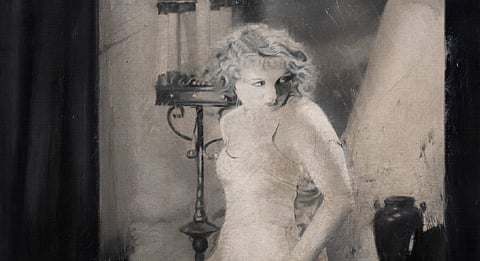Murder In An Artist’s Studio: How A Hitchcock Film Sparked Off Atul Dodiya’s New Set Of Paintings
Atul Dodiya is no ordinary cineaste. His notes, taken when he is watching a movie at home, reveal a strange practice: whenever Dodiya has to pause the movie, he writes down the reason behind it. While watching Kurosawa's Drunken Angel he took the first pause when he went to get some nuts to munch on. The second time he got up was to pour himself a glass of vodka and orange juice. Then at some point, his wife, artist Anju Dodiya, came looking for her phone and needed his help. Around 5 pm, he took out the chattai for vajrasana. At 6, he had to make a call to Sudhir Patwardhan, the painter and a colleague. Gangadhar, their house help, rang the bell at 9:30. Seven years ago, when he was watching The Godfather he received a text message that Bal Thackeray has died. He marks at which point he is pausing a movie – and sometimes takes photos of the frozen frame on his phone or camera. When juxtaposed with the corresponding notes, these images acquire a new meaning. He loves the movies and does this out of instinct, but he also sees it as a rich source for creative inspiration for his work.
His scribbles on movies, and movie-watching, don't necessarily translate into art all the time, but he is always looking for that spark that will trigger his next project. One of his early, breakthrough works, a self-portrait titled The Bombay Buccaneer, took off from a Baazigar poster. His show in Paris last month included three stills from the party scene in La Dolce Vita – the scene stayed with Dodiya because he liked the way one of the characters in it spoke about Morandi's paintings. Madhabi Mukherjee, from three films of Satyajit Ray, Mahanagar, Kapurush, Charulata, appear in Dodiya's "Saptapadi: Scenes from a Marriage (regardless)."

His new exhibition, Seven Minutes of Blackmail, is built around a seven-minute-sequence from Alfred Hitchcock's Blackmail. The sequence in question involves Alice (Anny Ondra) and Mr Crewe (Cyril Ritchard). The latter is a painter, and the setting of the action is his studio. Hitchcock packs in everything in these seven minutes, from the promise of a breezy love affair, to a rape attempt, to Alice's defence that leads to murder, to the paranoia that takes hold of her, to the appearance of the silhouette of a man wearing a hat – the blackmailer. These few minutes have enough dramatic ups and downs, and directorial flourishes that warrant obsessing over. Dodiya has selected 36 frames from the sequence, turning them into small oil on canvas paintings.
These seven minutes have enough dramatic ups and downs, and directorial flourishes that warrant obsessing over. Dodiya has selected 36 frames from the sequence, turning them into small oil on canvas paintings.
He enjoys the process of making paintings that look like photographs. To achieve the visual quality of the murder mystery set in a gaslit London of 1929, he "put thin layers of black tone, then removing some parts, and applying again." "It's not outright black and white. There is some golden touch, some ambarish, that looks like sepia but isn't really," he says while setting up the work at Chemould Prescott Road, where the exhibition will be shown from 16 January to February 21. He has noticed things that would't normally strike a first time viewer. He points at the scene where Mr Crewe, on the piano, tries to persuade Alice to give in; there's a devilish glow that is caused by the pattern of the light falling on his face from the wall behind. "Hitchcock is showing him as a villain, a kind of a monster," he says.

The process of arriving at each frame was painstaking, with even a fleeting, brief moment offering multiple shots and angles. Such as the bit where Alice, scared that she will be seen by one Mr Crewe's neighbours – and will later be accused for the murder – closes the door after exiting the house. "Because of your visual sense as a painter, you know where the gaze is, how the neck is being stretched, how the arm moves. Within that one moment, I must have taken some 10-15 pictures, to select what's the most dramatic one for painting," he says.
The set of paintings, that occupy the main viewing room at Chemould, is the centrepiece. The rest of the gallery's 500 square feet exhibition space is filled up with other media. The two art deco-deco-inspired cabinets in one room have seemingly random objects playing off each other: A tacky looking trophy, which was awarded to Dodiya by a magazine ten years ago, finds a place because its design matches the glowing bar-signboard from the movie, a photo of which is placed above it. There is a framed photo of the opening shot of the film in the other cabinet – one of the wheels of the Scotland Yard vehicle, and on the shelf beneath is a photo of Sridevi from one of Dodiya's earlier work because…murder mystery! Violent splashes of inky black collide and clash in one of the large abstracts, signifying the male character's aggression.
The sequence's uncanny timeliness with the MeToo movement, which has started conversations about male toxicity in the artist world, is accidental but not lost on Dodiya. It occurred to him a few months ago, but it didn't make him change direction he was heading. There's no one reason why he got drawn into the project, but the overall idea of it amuses him. "Imagine this: A British filmmaker, who was very young at the time before he got great success in Hollywood, made this film in 1929. And so many years later, an artist who lives in Ghatkopar, makes art out of a sequence in the film. That is something I wonder about," he says.

